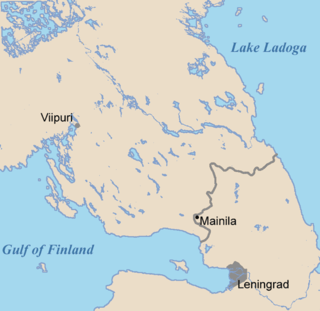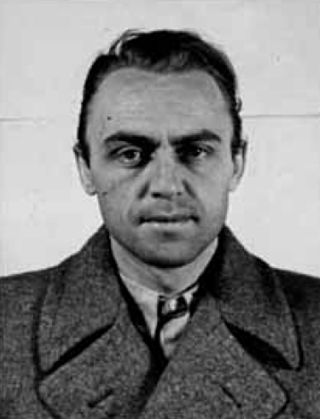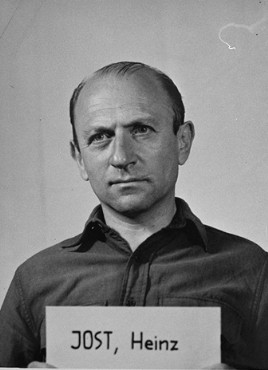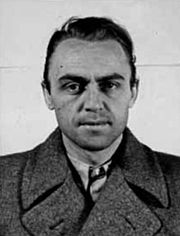
Heinrich Luitpold Himmler was the Reichsführer of the Schutzstaffel, a leading member of the Nazi Party of Germany, and one of the most powerful men in Nazi Germany, primarily known for being a main architect of the Holocaust.
Sicherheitsdienst, full title Sicherheitsdienst des Reichsführers-SS, or SD, was the intelligence agency of the SS and the Nazi Party in Nazi Germany. Established in 1931, the SD was the first Nazi intelligence organization and the Gestapo was considered its sister organization through the integration of SS members and operational procedures. The SD was administered as an independent SS office between 1933 and 1939. That year, the SD was transferred over to the Reich Security Main Office, as one of its seven departments. Its first director, Reinhard Heydrich, intended for the SD to bring every single individual within the Third Reich's reach under "continuous supervision".

Bloody Sunday was a sequence of violent events that took place in Bydgoszcz, a Polish city with a sizable German minority, between 3 and 4 September 1939, during the German invasion of Poland.

The Heim ins Reich was a foreign policy pursued by Adolf Hitler before and during World War II, beginning in 1938. The aim of Hitler's initiative was to convince all Volksdeutsche who were living outside Nazi Germany that they should strive to bring these regions "home" into Greater Germany, but also relocate from territories that were not under German control, following the conquest of Poland, in accordance with the Nazi–Soviet pact. The Heim ins Reich manifesto targeted areas ceded in Versailles to the newly reborn state of Poland, various lands of immigration, as well as other areas that were inhabited by significant ethnic German populations, such as the Sudetenland, Danzig, and the southeastern and northeastern regions of Europe after 6 October 1939.

The Invasion of Poland, also known as the September Campaign, Polish Campaign, War of Poland of 1939, and Polish Defensive War of 1939, was a joint attack on the Republic of Poland by Nazi Germany, the Slovak Republic, and the Soviet Union; which marked the beginning of World War II. The German invasion began on 1 September 1939, one week after the signing of the Molotov–Ribbentrop Pact between Germany and the Soviet Union, and one day after the Supreme Soviet of the Soviet Union had approved the pact. The Soviets invaded Poland on 17 September. The campaign ended on 6 October with Germany and the Soviet Union dividing and annexing the whole of Poland under the terms of the German–Soviet Frontier Treaty. The invasion is also known in Poland as the September campaign or 1939 defensive war and known in Germany as the Poland campaign.

The Venlo incident, was a covert operation carried out by the German Nazi Party's Sicherheitsdienst (SD) on 9 November 1939, which resulted in the capture of two British Secret Intelligence Service agents five metres (16 ft) from the German border, on the outskirts of the Dutch city of Venlo.

The Gleiwitz incident was a false flag attack on the radio station Sender Gleiwitz in Gleiwitz staged by Nazi Germany on the night of 31 August 1939. Along with some two dozen similar incidents, the attack was manufactured by Germany as a casus belli to justify the invasion of Poland. Prior to the invasion, Adolf Hitler gave a radio address condemning the acts and announcing German plans to attack Poland, which began the next morning. Despite the German government using the attack as a justification to go to war with Poland, the Gleiwitz assailants were not Polish but were German SS officers wearing Polish uniforms.

Operation Tannenberg was a codename for one of the anti-Polish extermination actions by Nazi Germany. The shootings were conducted with the use of a proscription list targeting Poland’s elite, compiled by the Gestapo in the two years before the invasion of Poland.

Bronislav Vladislavovich Kaminski was a Polish-Russian Nazi collaborator and the commander of the Kaminski Brigade, an anti-partisan and rear-security formation made up of people from the so-called Lokot Autonomy territory in the Nazi Germany occupied areas of the Soviet Union, which was later incorporated into the Waffen-SS as the SS Sturmbrigade RONA. Older publications mistakenly give his first name as Mieczyslaw. Under Kaminski's command, the unit committed numerous war crimes and atrocities in the German-occupied Soviet Union and Poland.

The Shelling of Mainila, or the Mainila incident, was a military incident on 26 November 1939 in which the Soviet Union's Red Army shelled the Soviet village of Mainila near Beloostrov. The Soviet Union declared that the fire originated from Finland across the nearby border and claimed to have had losses in personnel. Through that false flag operation, the Soviet Union gained a great propaganda boost and a casus belli for launching the Winter War four days later.

This timeline of events preceding World War II covers the events that affected or led to World War II.

Alfred Helmut Naujocks, alias Hans Müller, Alfred Bonsen, and Rudolf Möbert, was a German SS functionary during the Third Reich. He took part in the staged Gleiwitz incident, a false flag intended to provide the justification for the attack on Poland by Nazi Germany, which ultimately culminated in starting World War II.
Franciszek Honiok was a Polish man who is famous for having been the first victim of World War II, on the evening of 31 August 1939.

The Deutsche Volksliste, a Nazi Party institution, aimed to classify inhabitants of Nazi-occupied territories (1939-1945) into categories of desirability according to criteria systematised by Reichsführer-SS Heinrich Himmler. The institution originated in occupied western Poland. Similar schemes were subsequently developed in Occupied France (1940-1944) and in the Reichskommissariat Ukraine (1941-1944).

Karl Heinrich Wilhelm Koppe was a German Nazi commander. He was responsible for numerous atrocities against Poles and Jews in Reichsgau Wartheland and the General Government during the German occupation of Poland in World War II.

History of Pomerania between 1933 and 1945 covers the period of one decade of the long history of Pomerania, lasting from the Adolf Hitler's rise to power until the end of World War II in Europe. In 1933, the German Province of Pomerania like all of Germany came under control of the Nazi regime. During the following years, the Nazis led by Gauleiter Franz Schwede-Coburg manifested their power through the process known as Gleichschaltung and repressed their opponents. Meanwhile, the Pomeranian Voivodeship was part of the Second Polish Republic, led by Józef Piłsudski. With respect to Polish Pomerania, Nazi diplomacy – as part of their initial attempts to subordinate Poland into Anti-Comintern Pact – aimed at incorporation of the Free City of Danzig into the Third Reich and an extra-territorial transit route through Polish territory, which was rejected by the Polish government, that feared economic blackmail by Nazi Germany, and reduction to puppet status.

Jabłonków incident refers to the events of the night of 25–26 August 1939, along the Polish-Slovak border, when a group of German Abwehr agents attacked a rail station in Mosty. The main purpose of the attack was to capture the Jablunkov Pass, with its strategic railway tunnel, until the arrival of the German armed forces. The attackers were repelled by units of the Polish Army, and the incident is regarded as a prelude to the German invasion of Poland. The Jabłonków Incident has been named the first commando operation of the Second World War.

Heinz Jost was a German SS functionary during the Nazi era. He was involved in espionage matters as the Sicherheitsdienst or (SD) section chief of office VI of the Reich Security Main Office. Jost was responsible for genocide in eastern Europe as commander of Einsatzgruppe A from March–September 1942.

Stodoły is a district of Rybnik, Silesian Voivodeship, southern Poland. In the late 2013 it had about 600 inhabitants.

Hitler's 1 September 1939 Reichstag speech is a speech made by Adolf Hitler at an Extraordinary Session of the German Reichstag on 1 September 1939, the day of the German invasion of Poland. The speech served as public declaration of war against Poland and thus of the commencement of World War II.




















